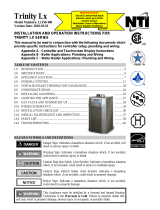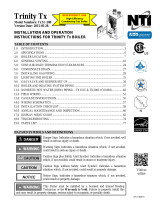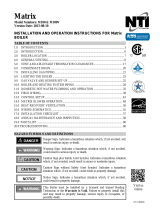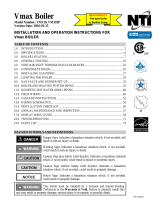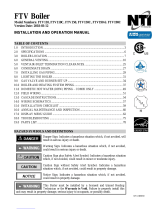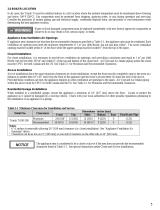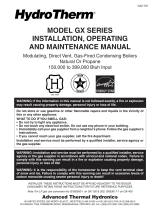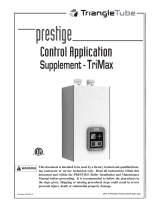Page is loading ...

Visit us
online
Trinity Tft
Model Numbers: Tft60 - 399
Version Date: 2015-06-24
INSTALLATION AND OPERATION INSTRUCTIONS FOR
TRINITY Tft BOILER
TABLE OF CONTENTS
1.0 INTRODUCTION ................................................................................................................ 3
2.0 SPECIFICATIONS .............................................................................................................. 6
3.0 BOILER LOCATION .......................................................................................................... 7
4.0 GENERAL VENTING ....................................................................................................... 10
5.0 VENT/AIR-INLET TERMINATION CLEARANCES ..................................................... 24
6.0 CONDENSATE DRAIN .................................................................................................... 26
7.0 INSTALLING GAS PIPING .............................................................................................. 28
8.0 LIGHTING THE BOILER ................................................................................................. 30
9.0 GAS VALVE AND BURNER SET-UP ............................................................................ 32
10.0 BOILER AND HEATING SYSTEM PIPING ................................................................... 35
11.0 LEAD LAG INSTRUCTIONS ........................................................................................... 46
12.0 FIELD WIRING ................................................................................................................. 49
13.0 WIRING SCHEMATICS ................................................................................................... 54
14.0 INSTALLATION CHECKLIST ........................................................................................ 56
15.0 ANNUAL MAINTENANCE AND INSPECTION ........................................................... 57
16.0 TROUBLESHOOTING ..................................................................................................... 59
17.0 PARTS LIST ...................................................................................................................... 81
HAZARD SYMBOLS AND DEFINITIONS
Danger Sign: Indicates a hazardous situation which, if not avoided, will
result in serious injury or death.
Warning Sign: Indicates a hazardous situation which, if not avoided,
could result in serious injury or death.
Caution Sign plus Safety Alert Symbol: Indicates a hazardous situation
which, if not avoided, could result in minor or moderate injury.
Caution Sign without Safety Alert Symbol: Indicates a hazardous
situation which, if not avoided, could result in property damage.
Notice Sign: Indicates a hazardous situation which, if not avoided,
could result in property damage.
This Boiler must be installed by a licensed and trained Heating
Technician or the Warranty is Void. Failure to properly install this
unit may result in property damage, serious injury to occupants, or possibly death.
NTI # 84535
H

Trinity │Installation and Operation Instructions Tft Series
2
Read Before Proceeding
If you do not follow these instructions exactly, a fire or explosion may result causing
property damage, serious injury or death.
FOR YOUR SAFETY, READ BEFORE OPERATING_
A) This boiler does not have a pilot. It is equipped with an ignition device which automatically lights the
burner. Do not try to light the burner by hand.
B) BEFORE OPERATING smell all around the boiler area for gas. Be sure to smell next to the floor
because some gas is heavier than air and will settle on the floor.
WHAT TO DO IF YOU SMELL GAS:
• Do not try to light any boiler.
• Do not touch any electric switch.
• Do not use any phone in your building.
• Immediately call your gas supplier from a neighbor's phone. Follow the gas supplier's instructions.
• If you cannot reach your gas supplier, call the fire department.
C) Use only your hand to turn the gas “shutoff” valve. Never use tools. If the handle will not turn by hand,
don't try to repair it, call a qualified service technician. Force or attempted repair may result in a fire or
explosion.
D) Do not use this boiler if any part has been under water. Immediately call a qualified service technician
to inspect the boiler and to replace any part of the control system and any gas control which has been
under water.
OPERATING INSTRUCTIONS_
1. STOP! Read the safety information above very carefully.
2. Set the thermostat to lowest setting. Turn off all electric power to the boiler.
3. This boiler does not have a pilot. It is equipped with an ignition device which automatically lights the
burner. Do not try to light the burner by hand.
4. Turn the manual gas valve to the OFF position. Remove front access panel.
5. Wait five (5) minutes to clear out any gas. Then smell for gas, including near the floor. If you smell gas,
STOP! Follow “B” in the safety information above. If you don't smell gas, go to the next step.
6. Turn the manual gas valve ON. Wait an additional five (5) minutes smelling for gas.
7. Replace the front access panel.
8. Set thermostat to highest setting. Turn on all electric power to the boiler.
9. Ignition sequence is automatic. Combustion will occur after a brief fan purge.
10. If ignition does not occur, follow the instructions “To Turn Off Gas To Boiler” and call your service
technician or gas supplier.
TO TURN OFF GAS TO THE BOILER_
1. STOP! Read the safety information above very carefully.
2. Turn off all electric power to the boiler.
3. Turn the manual gas valve to the OFF position.
Crystalline Silica - Certain components confined in the combustion chamber may
contain this potential carcinogen. Improper installation, adjustment, alteration, service or
maintenance can cause property damage, serious injury (exposure to hazardous materials) or death. Refer to
Section 14.0 for information on handling instructions and recommended personal protective equipment.
Installation and service must be performed by a qualified installer, service agency or the gas supplier (who must
read and follow the supplied instructions before installing, servicing, or removing this boiler. This boiler
contains materials that have been identified as carcinogenic, or possibly carcinogenic, to humans).
Void Warranty - This Boiler must have water flowing through it whenever the burner is
on or it will damage the unit and void the warranty. Failure to follow these instructions
may result in serious injury or death.

Tft Series Installation and Operation Instructions │Trinity
3
1.0 INTRODUCTION
General Installation Requirements
The installation of your NTI Trinity Tft gas boiler must conform to the requirements of this manual, your local
authority, and the National Fuel Gas Code ANSI Z223.1 and or CAN/CGA B149 Installation Codes. Where
required by the Authority, the installation must conform to the standard for “Controls and Safety Devices for
Automatically Fired Boilers ANSI/ASME CSD-1.
This document pertains to the correct installation and operation of NTI Trinity boiler model Tft. The instructions
detailed in this document supersede any and all previous instructions provided by NTI, written or otherwise.
Each unit is provided with the following:
1. Installation and Operating Instructions,
2. Appendix A – Controller and Touchscreen Display Instructions,
3. Trinity Users Manual, and
4. Natural Gas to LP Conversion Kit*
* The conversion kit is required to convert the boiler so it will safely operate with Propane Gas.
Read and understand this entire document prior to proceeding with the installation of the
Trinity Tft. Failure to follow the instructions outlined in this document will result in
property damage, serious injury or death.
Energy Saving Feature - This boiler is equipped with a feature that saves energy by
reducing the boiler water temperature as the heating load decreases. This feature is
equipped with an override which is provided primarily to permit the use of an external energy management
system that serves the same function. THIS OVERRIDE MUST NOT BE USED UNLESS AT LEAST ONE
OF THE FOLLOWING CONDITIONS IS TRUE :
An external energy management system is installed that reduces the boiler water temperature as the heating
load decreases.
This boiler is not used for any space heating.
This boiler is part of a modular or multiple boiler system having a total input of 300,000 BTU/hr or greater.
This boiler is equipped with a tankless coil.
User Responsibilities
This boiler must be installed and serviced by a qualified installer or service technician. This boiler must be
serviced and inspected annually when operating in normal residential applications. Demanding applications or
extreme conditions (i.e. commercial) may require more frequent service and inspection. As the User/Owner of
this equipment, you are responsible for ensuring the maintenance is performed at the required intervals (see
Section 14 – Annual Maintenance and Inspection).
Failure to have the boiler properly serviced and inspected on a regular basis by a qualified
service technician may result in property damage, serious injury or death.
Failure to keep the Vent and Combustion Air Intake clear of ice, snow, and other debris
may result in property damage, serious injury, or death.
Installer Responsibilities
As the installing technician it is your responsibility to ensure the installation is performed in accordance with this
instruction manual as well as any applicable local or National installation codes. It is also your responsibility to
inform the User/Owner of their obligation with respect to the above description under “User Responsibilities”.
Failure to follow this warning could result in fire, serious injury, or death.

Trinity │Installation and Operation Instructions Tft Series
4
Failure to use the appropriate Natural to LP Conversion Kit and Orifice when operating
the Trinity Tft with Propane will result in extremely dangerous burner operation leading
to property damage, serious injury or death. Refer to section titled ATTENTION:
LIQUEFIED PETROLEUM (LP) PROPANE for applicable conversion kit and LP
orifice numbers.
ATTENTION: LIQUEFIED PETROLEUM (LP) PROPANE
The Trinity Tft is factory set to operate with Natural Gas. BEFORE OPERATING WITH PROPANE, the
specified LP Conversion Kit and Orifice must be installed to convert the boiler so it will operate safely with
LP Propane. The correct kit and LP orifice is listed below (Each kit comes with conversion instructions).
Liquefied Petroleum (LP) propane gas is heavier than air; therefore, it is imperative that your Trinity Tft boiler
is not installed in a pit or similar location that will permit heavier than air gas to collect. Local Codes may
require boilers fueled with LP gas be provided with an approved means of removing unburned gases from the
room. Check your local codes for this requirement.
Natural to LP Propane Conversion Kit_
Model Number Kit Number LP Orifice
Tft60-85 82650-1 415 (4.15mm)
Tft110 82650-1 52 (5.2mm)
Tft155-250 82650-1 62 (6.2mm)
Tft300-399 84471-1 74 (7.4mm)
Boiler Vent / Air-Inlet Piping
The Trinity Tft is certified as a “Category IV” boiler, and requires a “Special Venting
System” designed for pressurized venting. The exhaust gases must be piped directly to
the outdoors using the vent materials and rules outlined in these instructions. Failure to
follow these instructions will result in serious injury or death.

Tft Series Installation and Operation Instructions │Trinity
5
IN THE STATE OF MASSACHUSETTS ONLY
(a) For all horizontally vented gas fueled equipment installed in every dwelling, building or structure used in whole or
in part for residential purposes, including those owned and operated by the Commonwealth and where the side wall
exhaust vent termination is less than seven (7) feet above finished grade in the area of the venting, including but not
limited to decks and porches, the following requirements shall be satisfied:
1. INSTALLATION OF CARBON MONOXIDE DETECTORS At the time of installation of the side wall
horizontal vented gas fueled equipment, the installing plumber or gas fitter shall observe that a hard wired
carbon monoxide detector with an alarm and battery back-up is installed on the floor level where the gas
equipment is to be installed and on each additional level of the dwelling, building or structure served by the
equipment. It shall be the responsibility of the property owner to secure the services of qualified licensed
professionals for the installation of hard wired carbon monoxide detectors.
a. In the event that the side wall horizontally vented gas fueled equipment is installed in a crawl space or an
attic, the hard wired carbon monoxide detector with alarm and battery back-up may be installed on the next
adjacent floor level.
b. In the event that the requirements of this subdivision can not be met at the time of completion of
installation, the owner shall have a period of 30 days to comply with the above requirements; provided,
however, that during said 30 day period a battery operated carbon monoxide detector with an alarm shall
be installed.
2. APPROVED CARBON MONOXIDE DETECTORS Each carbon monoxide detector as required in accordance
with the above provisions shall comply with NFPA 720 and be ANSI/UL 2034 listed and IAS certified.
3. SIGNAGE A metal or plastic identification plate shall be permanently mounted to the exterior of the building
at a minimum height of eight (8) feet above grade directly in line with the exhaust vent terminal for the
horizontally vented gas fueled heating boiler or equipment. The sign shall read, in print size no less than one-
half (1/2) inch in size, “GAS VENT DIRECTLY BELOW. KEEP CLEAR OF ALL OBSTRUCTIONS”
(plate included with boiler).
4. INSPECTION The state or local gas inspector of the side wall horizontally vented gas fueled equipment shall
not approve the installation unless, upon inspection, the inspector observes carbon monoxide detectors and
signage installed in accordance with the provisions of 248 CMR 5.08(2)(a)1 through 4.
(b) EXEMPTIONS: The following equipment is exempt from 248 CMR 5.08(2)(a)1 through 4:
1. The equipment listed in Chapter 10 entitled “Equipment Not Required To Be Vented” in the most current
edition of NFPA 54 as adopted by the Board; and
2. Product Approved side wall horizontally vented gas fueled equipment installed in a room or structure separate
from the dwelling, building or structure used in whole or in part for residential purposes.
(c) MANUFACTURER REQUIREMENTS – GAS EQUIPMENT VENTING SYSTEM PROVIDED: When the
manufacturer of Product Approved side wall horizontally vented gas equipment provides a venting system design or
venting system components with the equipment, the instructions provided by the manufacturer for installation of the
equipment and the venting system shall include:
1. Detailed instructions for installation of the venting system design or the venting system components; and
2. A complete parts list for the venting system design or venting system.
(d) MANUFACTURER REQUIREMENTS – GAS EQUIPMENT VENTING SYSTEM NOT PROVIDED:
When the manufacturer of a Product Approved side wall horizontally vented gas fueled equipment does not provide
the parts for venting the flue gases, but identifies “special venting systems”, the following requirements shall be
satisfied by the manufacturer:
1. The referenced “special venting system” instructions shall be included with the appliance or equipment
installation instructions; and
2. The “special venting system” shall be Product Approved by the Board, and the instructions for that system shall
include a parts list and detailed installation instructions.
(e) A copy of all installation instructions for all Product Approved side wall horizontally vented gas fueled equipment,
all venting instructions, all parts list for venting instructions, and/or all venting design instructions shall remain with
the appliance or equipment at the completion of the installation.

Trinity │Installation and Operation Instructions Tft Series
6
2.0 SPECIFICATIONS
Table 2-1 Trinity Tft Specifications
DESCRIPTION
Tft60
Tft85
Tft110
Tft155
Tft175
Tft200
Tft250
Tft300
Tft399
CSA Input Modulation 1,4
[MBH]
17-60
17-85
21.6-108
31-155
31-175
31-200
31-250
79.8-299
79.8-399
DOE Heating Capacity 1,2
[MBH]
56
78
99
144
163
185
230
278
380
Net I=B=R Rating 1,2
[MBH]
48
68
86
125
141
160
199
239
330
DOE AFUE 2 [%]
95
95
95
95
95
95
95
94
95.4
Water Connections – NPT
[in.]
1 (Male)
1-1/4 (Male)
1-1/2 (Male)
Gas Connection - NPT, in.
½ (Male)
¾ (Male)
Vent/Air-inlet Pipe Diameter
[in.] 3
2 or 3
3
4
Dimensions H x W x D [in.]
33-3/8 x 19-3/4 x 14-1/2
33-3/8 x 19-3/4 x 18-1/2
36-3/8 x 25-1/4 x 20
Approx. Boiler Weight
with Water [lbs]
110
180
250
Approx. Boiler Water
Content [Gallons]
3.2
4.9
6.4
Electrical Rating
120V/1Ph/60Hz/less than12A
Notes:
1 Listed Input and Output ratings are at minimum vent lengths at an altitude of 0-2000ft. Numbers will be lower with
longer venting and/or altitudes greater then 2000ft.
2 Ratings based on standard test procedures prescribed by the U.S. Department of Energy; certified by AHRI. Tft399
efficiency represents Thermal Efficiency (AFUE is not applicable).
3 Trinity Tft requires a special venting system, use only vent materials and methods detailed in these instructions.
4 When operating with Propane models Tft60, Tft85 and Tft110 have min/max Input Modulation rates of 17/65, 17.6/88
and 22.6/113 MBH respectfully.
Wall mounting of unit requires two people to lift the boiler into place. Failure to follow
these instructions may result in property damage or personal injury.
High Altitude Operation
The Trinity Tft is designed to operate at its maximum listed capacity in installations located at 0-2000ft above
Sea Level. Since the density of air decreases as elevation increases, maximum specified capacity should be de-
rated for elevations above 2000 ft [610 m] in accordance with Table 2-2.
Table 2-2 De-rate % for High Altitudes
Elevations
2001 ft [610 m]
3000 ft [914 m]
4000 ft [1219 m]
4500 ft [1372 m]
5000 ft [1524 m]
In Canada 1
de-rate by 10%
de-rate by 10%
de-rate by 10%
de-rate by 10%
de-rate % may vary
In USA 2
-
de-rate by 12%
de-rate by 16%
de-rate by 18%
de-rate by 20%
Notes:
1 Canada: Altitudes between 2000-4500 ft [610-1372 m], de-rate by 10%. Consult local authorities for de-rating
capacities for altitudes above 4500 ft [1372 m].
2 USA: De-rate capacity by 4% for every 1000 ft [305 m], if altitude is above 2000 ft [610 m].
Combustion – At elevations above 2000 feet, the combustion of the boiler must be
checked with a calibrated combustion analyzer to ensure safe and reliable operation. It is
the Installers responsibility to check the combustion and to adjust the combustion in
accordance with Section 9.0. Failure to follow these instructions may result in property
damage, serious injury, or death.

Tft Series Installation and Operation Instructions │Trinity
7
3.0 BOILER LOCATION
In all cases, the Trinity Tft must be installed indoors in a dry location where the ambient temperature must be
maintained above freezing and below 100F [38C]. All boiler components must be protected from dripping,
spraying water, or rain during operation and servicing. Consider the proximity of system piping, gas and
electrical supply, condensate disposal drain, and proximity to vent termination when determining the best boiler
location.
Water or flood damaged components must be replaced immediately with new factory-
approved components as failure to do so may result in fire, serious injury, or death.
Boiler Area Ventilation Air Openings
Direct Vent – If boiler area clearances are less than the recommended clearances specified in Table 3-1, the
boiler area must be ventilated (Exception: if the boiler area/room has a volume of 150 ft3 or greater,
ventilation of the boiler room is not required). Each ventilation air opening must meet the minimum
requirements of 1 in2 per 1000 Btu/hr, but not less than 100 in2. The lower ventilation opening must be
located within 6” of the floor while the upper opening must be located 6” from the top of the space.
If the "Boiler Area" does not meet the recommended clearances listed in Table 3-1, and if
the boiler area has a volume less than 150 ft3, it is considered a Closet or Alcove. PVC
vent pipe and fittings shall not be used within the closet or alcove; only approved CPVC,
Polypropylene or Stainless Steel vent pipe and fittings can be used. See Table 4-4 for a
list of approved materials. Under all circumstances, the minimum clearances listed in
Table 3-1 must be provided.
Indoor Combustion Air – When using Indoor Combustion Air in lieu of Direct Vent air-inlet piping, provisions
for combustion and ventilation air, in accordance with section “Air for Combustion and Ventilation,” of the
National Fuel Gas Code, ANSI Z223.1/NFPA 54 (U.S.), or Clause 8.2, 8.3 or 8.4 of Natural Gas and Propane
Installation Code, CAN/CSA B149.1 (Canada), or applicable provisions of the local building codes, must be
adhered to.
Closet Installations
For closet installations it is necessary to provide two ventilation air openings as shown in Figure 3-1, each
providing a minimum area equal to 1 in2 per 1000 Btu/hr, but not less then 100 in2 and within 6” of the top and
bottom of the closet door. See Table 3-1 for minimum clearances.
Alcove Installations
Alcove installations have the same minimum clearances as closet installations, except the front must be
completely open to the room at a distance no greater then 18” [457 mm] from the front of the boiler and the
room is at least three (3) times the size of the alcove. Provided these conditions are met, the boiler requires no
extra ventilation air openings to the space. See Table 3-1for minimum clearances.
Residential Garage Installations
When installed in a residential garage, mount the boiler a minimum of 18” [457 mm] above the floor. Locate or
protect the boiler so it cannot be damaged by a moving vehicle. Check with your local authorities for other
possible regulations pertaining to the installation of a boiler in a garage.
Wall Mounting Installations
The Tft is provided with integrated wall mounting brackets. Refer to Figure 3-2 for instructions and illustrations
on wall mounting.

Trinity │Installation and Operation Instructions Tft Series
8
Table 3-1 Minimum Clearances for Installation and Service
Model No.
Clearances
Dimensions - inches [mm]
Front
Top
Sides
Back
Bottom
Flue Pipe
Trinity Tft
Minimum
24 [610] 1
12 [305]
4 [102]
0
9 [229]
1 [25]
Recommended
36 [914]
24 [610]
12 [305]
0
24 [610]
1 [25]
Notes:
1 6” if surface is removable allowing a minimum of 24” [610 mm] clearance (i.e. closet installation). See Ventilation Air
Opening dimensions in Figure 3-1.
Closet/alcove installations in US and Canada require approved CPVC, Polypropylene or
Stainless Steel vent and air-inlet pipe and fittings (see Table 4-4); PVC is not permitted.
Failure to follow these instructions may result in damage or serious injury.
Figure 3-1 Closet Installation, Minimum Clearances
(Model Tft60-110 Shown)
Ventilation Air Openings
are not required if the
boiler area meets the
Recommended Clearances
listed in Table 3-1.
Bottom ventilation
opening Max. 6” above
floor / bottom
Top ventilation opening
Max. 6” below ceiling / top
Sides = 4”
Front = 6”
(if removable)
Removable surface /
closet door
Ventilation air opening
1in2 per 1000 Btu/hr,
min. 100in2
Ventilation air opening
1in2 per 1000 Btu/hr,
min. 100in2
Min. 1” clearance
for hot water and
vent pipes
Bottom = 9”
Top = 12”

Tft Series Installation and Operation Instructions │Trinity
9
Figure 3-2 Wall Mounting Instructions
While leaving the Upper bracket (A) intact,
remove the Wall-mount bracket (B) attached
to the bottom-back of the appliance. Save the
mounting hardware for Step 4.
Secure the Wall-mount bracket (B), removed
from the bottom of the boiler in Step 1, to a
solid wall using field supplied lag screws
(anchors when mounting to a concrete wall)
that are adequate to support the weight of the
appliance (refer to Table 2-1 Specifications).
Ensure the Wall-mount bracket is mounted
level and flush to the wall with mounting holes
on the bottom, flange pointed upward and
angled away from the wall.
Mount the appliance to the wall by aligning the
Upper bracket (A) with the Wall-mount
bracket (B). Slide the Upper bracket down
over the wall mount bracket until it hooks.
Once the appliance is resting securely on the
Upper bracket, secure the Bottom bracket (C)
to the underside of the appliance using the
mounting hardware removed in Step 1; then,
anchor the bottom bracket to the wall as shown
using field supplied hardware.
Failure to follow instructions may
result in fire, serious injury, or death.
This unit requires two people to lift it
or damage and injury may result.
Upper bracket (A)
Wall-mount
bracket (B)
Wall-mount
bracket (B)
Wall
Boiler
Ensure bracket
(A) fully inserts
into bracket (B)
(B)
(A)
Bottom bracket (C) shipped
with boiler package

Trinity │Installation and Operation Instructions Tft Series
10
4.0 GENERAL VENTING
The Trinity Tft is certified as a “Category IV” boiler requiring a “Special Venting System” designed for
pressurized venting. The Exhaust Vent must be piped to the outdoors, using the vent materials and rules outlined
in this section. Under no conditions may this unit vent gases into a masonry chimney, unless it is vacant, and
utilizes the approved venting material and rules described in this section.
Vent and Air-inlet are to be piped separately. The Trinity Tft cannot share a common vent
or air-inlet with multiple boilers; unless the common venting system has been certified by
NTI (Contact NTI for details). Failure to comply will result in serious injury or death.
Removing an Existing Boiler from Common Venting System
Do not install the Trinity Tft into a common venting system with any other boiler. Failure
to comply with this warning will cause flue gas spillage and leech carbon monoxide
emissions into the surrounding air resulting in serious injury or death.
When an existing boiler is removed from a common venting system, the common venting
system is likely to be too large for proper venting of the remaining boilers connected to
it. Instructions have been provided on how to remove the existing boiler and how to
resize the remaining venting system. Failure to follow these instructions may result in
property damage, serious injury or death.
Upon removal of an existing boiler, the following steps shall be followed for each boiler remaining in the
common venting system; prior to commencing this procedure, shutdown all boilers remaining in the common
venting system.
Steps to Removing an Existing Boiler:
1. Seal any unused openings in the common venting system.
2. Visually inspect the venting system for proper size and horizontal pitch. Verify that there is no blockage,
restriction, leakage, corrosion or other deficiencies which could cause an unsafe condition.
3. Insofar as is practical, close fireplace dampers, all building doors and windows and all doors between the
space in which the boilers remaining connected to the common venting system are located and other spaces
of the building. Turn on clothes dryers and any boiler not connected to the common venting system. Turn on
any exhaust fans, such as range hoods and bathroom exhausts, so they will operate at maximum speed. Do
not operate a summer exhaust fan.
4. Place in operation the boiler being inspected. Follow the applicable lighting instructions. Adjust thermostat
so boiler will operate continuously.
5. Test for spillage at the draft hood relief opening after 5 minutes of main burner operation. Use the flame of a
match or candle, or smoke from a cigarette, cigar or pipe.
6. After it has been determined that each boiler remaining connected to the common venting system properly
vents when tested as outlined above, return doors, windows, exhaust fans, fireplace dampers and any other
gas burning boiler to their previous condition of use.
7. Any improper operation of the common venting system should be corrected so the installation conforms to
the National Fuel Gas Code, ANSI Z223.1/NFPA 54 and/or CAN/CSA B149.1, Natural Gas and Propane
Installation Code. When resizing any portion of the common venting system, the common venting system
should be resized to approach the minimum size as determined using the appropriate tables in Part 11 of the
National Fuel Gas Code, ANSI Z223.1/NFPA 54 and/or CAN/CSA B149.1, Natural Gas and Propane
Installation Code.

Tft Series Installation and Operation Instructions │Trinity
11
Direct Vent Installation
When installed as a Direct Vent boiler the combustion air-inlet must also be piped directly to the outdoors using
the methods described in this section and in accordance with the National Fuel Gas Code, ANSI Z223.1 (U.S.) or
CSA B149.1 (Canada) and local requirements.
Indoor Combustion Air (non-Direct Vent)
When the installation uses Indoor Combustion Air (i.e. piping is not directly connecting the appliance air-inlet
fitting to the outdoors), provisions for combustion and ventilation air, in accordance with section “Air for
Combustion and Ventilation,” of the National Fuel Gas Code, ANSI Z223.1/NFPA 54 (U.S.), or Clause 8.2, 8.3
or 8.4 of Natural Gas and Propane Installation Code, CAN/CSA B149.1 (Canada), or applicable provisions of
the local building codes, must be adhered to.
The boiler shall be located so as not to interfere with proper circulation of combustion,
ventilation, and dilution air.
Make up air requirements for the operation of exhaust fans, kitchen ventilation systems,
clothes dryers, and fireplaces shall be considered in determining the adequacy of a space
to provide combustion air requirements. Failure to ensure adequate make up air to all
appliances may result in personal injury or death.
Combustion Air-inlet Contamination
Be careful not to locate the air-inlet termination in an area where contaminants can be drawn in and used for
combustion. Combustion air containing dust, debris or air-borne contaminants will drastically increase the
required maintenance and may cause a corrosive reaction in the Heat Exchanger which could result in premature
failure, fire, serious injury, or death. See Table 4-1 for a list of areas to avoid when terminating air-inlet piping:
Table 4-1 Corrosive Products and Contaminant Sources
Products to Avoid
Contaminated Sources to Avoid
Antistatic fabric softeners, bleaches, detergents, cleaners
Laundry facilities
Perchloroethylene (PCE), hydrocarbon based cleaners
Dry cleaning facilities
Chemical fertilizer, herbicides/pesticides, dust, methane gas
Farms or areas with livestock and manure
Paint or varnish removers, cements or glues, sawdust
Wood working or furniture refinishing shops
Water chlorination chemicals (chloride, fluoride)
Swimming pools, hot tubs
Solvents, cutting oils, fiberglass, cleaning solvents
Auto body or metal working shops
Refrigerant charge with CFC or HCFC
Refrigerant repair shops
Permanent wave solutions
Beauty shops
Fixer, hydrochloric acid (muriatic acid), bromide, iodine
Photo labs, chemical / plastics processing plants
Cement powder, crack fill dust, cellulose, fiber based insulation
Concrete plant or construction site
Do not store or use gasoline or other flammable vapors and liquids in the vicinity of this
or any other boiler. Failure to follow instructions may result in serious injury or death.
It is BEST PRACTICE to pipe the combustion air-inlet directly to the outdoors (Direct
Vent installation) to avoid contamination often contained in indoor air.
Flammable Solvents and Plastic Piping
Due to the extremely flammable characteristics of most glues, cements, solvents and primers used in the process
of joining plastic vent and air-inlet pipe, explosive solvent vapors must be evacuated from the vent and air-inlet
prior to start-up. Avoid using excess cement or primer that may lead to pooling inside the pipe assembly. Freshly
assembled piping assembly should be allowed to cure for a minimum of 8 hours before applying power to the gas
fired boiler. Refer to Mandatory Pre-commissioning Procedure for Plastic Venting in this section.
Flammable Cements and Primers – It is the installers’ responsibility to familiarize
themselves with the hazards associated with explosive solvents and to take all precautions
to reduce these risks. Failure to follow these instructions can cause explosions, property
damage, injury or death.

Trinity │Installation and Operation Instructions Tft Series
12
Mandatory Pre-commissioning Procedure for Plastic Venting (PVC or CPVC)
Do not apply power to the boiler prior to Step 4 in the Mandatory Pre-commissioning
Procedure for Plastic Venting.
1) Working with the power turned off to the boiler, completely install the vent and air intake system, securely
cementing joints together. If possible, allow primers/cements to cure for 8 hours before firing the burner. If
curing time is less than 8 hours, proceed with Steps 2 through 6.
2) Maintain the boiler gas supply shut-off valve in the off position.
3) Remove the cable from the Spark Ignition Transformer.
Spark Ignition Circuit - Maintain a safe distance (2 inches minimum) from the spark
ignition circuit to avoid injury from electrical shock.
4) Turn power on to the boiler and apply a heat demand.
5) Allow for 3 complete trials for ignition, consisting of pre and post purge of the combustion blower, until an
ignition lockout occurs. Repeat the process two more times (i.e. 9 complete ignition sequences in total).
6) Turn power off and reconnect the cable to the Spark Ignition Transformer.
Near Boiler Vent/Air-inlet Piping
Each Trinity Tft is equipped with a short piece of approved CPVC vent pipe which is to be used when venting
with PVC. Insert one end into the boiler flue outlet adapter and cement the other to the field venting (see Table 4-
4 for approved venting material). The CPVC vent pipe should extend fully into the boiler flue outlet adapter (see
Table 4-2). Ensure that the venting system does not apply a load or strain on the boiler flue outlet adapter. The
manufacturer recommends using two elbows to create a “swing joint” to reduce potential strain on vent piping
and cemented joints. See Figures 4-2 through 4-4 for illustrations.
Gasket Seating - Improper seating can cause leakage and eventual failure of the sealing
gasket. Ensure the vent pipe is adequately beveled prior to inserting into the boiler flue
adapter. Failure to follow these instructions may result in serious injury or death.
PVC Exhaust Venting – DO NOT insert PVC pipe directly into the appliance exhaust
adapter, as it can deform from the clamping force of the gear clamp. Failure to follow
these instructions may result in gasket failure and/or the dislodging of the exhaust pipe
from the appliance adapter, resulting in property damage, serious injury or death.
Polypropylene or Stainless Steel Venting – When using Polypropylene or Stainless Steel
piping, the appropriate appliance adapters must be used to transition the appliance vent
connections to accept the respective Polypropylene or Stainless Steel venting. See Table
4-3 for a list of approved adapters. Failure to use the correct adapter will result in flue gas
leakage resulting in property damage, serious injury or death.

Tft Series Installation and Operation Instructions │Trinity
13
Figure 4-2(a) Trinity Tft60-110 & 300-399
Figure 4-2(b) Trinity Tft60-110 & 300-399
Near Boiler Venting (CPVC)
Near Boiler Venting (PVC)
Figure 4-2(c) Trinity Tft155-250
Figure 4-2(d) Trinity Tft155-250
Near Boiler Venting (CPVC)
Near Boiler Venting (PVC)
Air-inlet - check with applicable local codes for acceptable pipe material.
Exhaust venting must be supported to reduce strain on piping joints. Failure to follow
these instructions may result in result in damage, serious injury or death.
In Canada, the first 3 ft (915 mm) of vent piping must be readily accessible for inspection.
Flue Outlet
Adapter (factory
supplied)
CPVC Exhaust
Vent
Swing Joint
to attain slope in
horizontal runs
Air-inlet
Pipe *
Air Inlet
Adapter
(factory
supplied)
PVC Coupling
Air Inlet
Adapter
(factory
supplied)
Swing Joint
to attain slope in
horizontal runs
PVC Exhaust Vent -
(check local codes
and Table 4-3)
Mandatory Vent Pipe
Transition Pipe
See Table 4-2.
Air-inlet
Pipe *
CPVC Transition
Pipe - minimum 5”
long (factory supplied)
Flue Outlet
Adapter (factory
supplied)
Flue Outlet
Adapter (factory
supplied)
CPVC Exhaust
Vent
Swing Joint
to attain slope in
horizontal runs
Air-inlet Pipe *
Air Inlet Adapter
(factory supplied)
PVC Coupling
Air Inlet
Adapter
(factory
supplied)
Swing Joint to attain
slope in horizontal runs
PVC Exhaust Vent -
(check local codes
and Table 4-3)
Mandatory Vent Pipe
Transition Pipe
See Table 4-2.
Air-inlet
Pipe *
CPVC Transition
Pipe - minimum 5”
long (factory supplied)
Flue Outlet
Adapter (factory
supplied)

Trinity │Installation and Operation Instructions Tft Series
14
Figure 4-2(e) Trinity Tft60-110 & 300-399
Figure 4-2(f) Trinity Tft60-110 & 300-399
Near Boiler Venting (Stainless Steel)
Near Boiler Venting (Polypropylene)
Figure 4-2(g) Trinity Tft155-250
Figure 4-2(h) Trinity Tft155-250
Near Boiler Venting (Stainless Steel)
Near Boiler Venting (Polypropylene)
Air-Inlet - check with applicable local codes for acceptable pipe material.
Exhaust venting must be supported to reduce strain on piping joints. Failure to follow
these instructions may result in damage, serious injury or death.
In Canada, the first 3 ft (915 mm) of vent piping must be readily accessible for inspection.
Flue Outlet
Adapter (factory
supplied)
SS Exhaust
Vent
Swing Joint
to attain slope in
horizontal runs
SS Air-inlet Pipe
SS Appliance Adapter
(see Table 4-3)
Air Inlet Adapter
(factory supplied)
Air-inlet Adapter
(factory supplied)
PPS Elbow
w/ offset angle to
account for slope
PPS Exhaust Vent
PPS Air-inlet Pipe*
PPS Appliance Adapter
(see Table 4-3)
Flue Outlet Adapter
(factory supplied)
Flue Outlet
Adapter (factory
supplied)
SS Exhaust
Vent
Swing Joint
to attain slope in
horizontal runs
SS Air-inlet Pipe
FasNSeal Appliance
Adapter (see Table 4-3)
Air Inlet Adapter
(factory supplied)
PPS Appliance Adapter
(see Table 4-3)
Air Inlet Adapter
(factory supplied)
PPS Elbow
w/offset angle to
account for slope
PPS Exhaust Vent
PPS Air-inlet Pipe*
Flue Outlet Adapter
(factory supplied)

Tft Series Installation and Operation Instructions │Trinity
15
Table 4-2 CPVC Vent Pipe Transition Piece (used when venting with PVC)
Model No.
Vent Pipe Size
CPVC Transition Vent Pipe Length
Full Insertion Depth
Tft60-110
3”
Minimum 5” [127 mm]
2-7/8” [73 mm]
Tft155-250
3”
Minimum 5” [127 mm]
2-5/8” [67 mm]
Tft300-399
4”
Minimum 5” [127 mm]
2-5/8” [67 mm]
Table 4-3 Appliance Adapters for Polypropylene and Stainless Steel Venting
Model No.
Vent Material
Venting Brand
Adapter Part No. 1,2
Tft60-250
Polypropylene
DuraVent – PolyPro
300150
Centrotherm - InnoFlue
ISAA0303
Stainless Steel
DuraVent – FasNSeal
300715
Tft300-399
Polypropylene
DuraVent – PolyPro
300151
Centrotherm - InnoFlue
ISAA0404
Stainless Steel
DuraVent – FasNSeal
303631
Notes:
1 Listed appliance adapters are only approved for use with the respective venting brand; i.e. a PolyPro appliance adapter
shall not be used with InnoFlue venting.
2 PolyPro and FasNSeal appliance adapters are available from DuraVent (1-800-835-4429 or www.duravent.com);
InnoFlue appliance adapters are available from Centrotherm Eco Systems (1-877-434-3432 or www.centrotherm.us.com).
Vent/Air-inlet Pipe Material
Table 4-4 Acceptable Vent and Air-Inlet Pipe Material
Items 1
Materials 2, 3
Venting System Standards
All Vent and Air-Inlet
materials installed on gas
fired appliances in CAN/US
must meet the Standards
listed in this Table. Failure
to comply could result in
fire, serious injury or death.
United States
Canada 4
Vent Piping
and Fittings
PVC - DWV
ANSI/ASTM D2265
All venting material in
Canada must be
ULC S636 approved.
See Note 4 below for
appropriate temperature
applications.
PVC Schedule 40
ANSI/ASTM D1785
CPVC Schedule 40
ANSI/ASTM F441
Stainless Steel (SS)
UL-1738
Polypropylene (PP)
-
Pipe Cement
PVC
ANSI/ASTM D2564
CPVC
ANSI/ASTM F493
Primers
PVC / CPVC
ANSI/ASTM F656
Notes:
1 Refer to Table 4-5 for Allowable Vent and Air-Inlet Pipe Sizes and Lengths.
2 PVC venting (exhaust and air-inlet) is not permitted within the Closet/alcove of a Closet/alcove installation.
3 The Air-inlet does not require high temperature pipe material. Check applicable local codes for acceptable materials.
4 ULC S636 PVC is approved for flue gas temperatures up to 149oF (65oC) and must only be used for low temperature
applications. High temperature applications requiring boiler supply water temperatures greater than 140oF (60oC) must
use ULC S636 CPVC, PP or SS.
The use of cellular core PVC (ASTM F891), cellular core CPVC, or Radel®
(polyphenolsulfone) in the exhaust venting system is prohibited. Failure to follow these
instructions may result in property damage, personal injury or death.
Covering non-metallic vent pipe and fittings with thermal insulation is prohibited. Failure
to follow these instructions may result in property damage, personal injury or death.

Trinity │Installation and Operation Instructions Tft Series
16
Vent/Air-inlet Pipe Length Determination
Use Table 4-5 to determine the maximum pipe length that can be used. The table calculates 90º elbows, and 45º
elbows at 5 equivalent feet each.
Example: When using 3” pipe, a Tft60-110 can be installed with 150 equivalent feet of air-inlet piping and 150
equivalent feet of exhaust-vent piping. See Table 4-5 for more details.
Models Tft60-110 require a minimum equivalent exhaust vent length of 15’. When
operating on Propane, models Tft60-110 require a minimum air-inlet length of 6’ and 11’
for 2” and 3” venting respectfully.
Table 4-5 Allowable Vent and Air-inlet Pipe Size and Lengths
Model No.
Pipe
Size
Gas
Length
(ft)
Number of Elbows (90’s or 45’s) and Equivalent Feet
1
2
3
4
5
6
7
8
9
Tft60-110
2” 1
NG
100
95
90
85
80
75
70
65
60
55
Tft60-85
LP
35
30
25
20
15
10
5
-
-
-
Tft110
25
20
15
10
5
-
-
-
-
-
Tft60-110
3”
NG/LP
150
145
140
135
130
125
120
115
110
105
Tft155-250
100
95
90
85
80
75
70
65
60
55
Tft300-399
4”
100
95
90
85
80
75
70
65
60
55
Note:
1 See WARNING below.
PVC Exhaust Venting – When using 2” PVC venting with models Tft60-110, the first
seven (7) equivalent feet of exhaust venting must be approved 2” CPVC or 3” PVC; see
exceptions in Table 4-4 and Figures 4-2b and 4-2d.
Termination Options – Direct Vent Installation
The venting system of the Tft may be terminated using field supplied piping to construct a “Two-Pipe”
termination, see Figures 4-3a, 4-4a, 4-4d, 4-5a, 4-6a and 4-6d; alternatively the venting may be terminated using
a factory kit selected from Table 4-6. The “IPEX Low Profile” kit (see Figures 4-3b and 4-5c) and “M&G
DuraVent Concentric (Wall)” kit (see Figures 4-3d and 4-5d) can be used for Sidewall terminations, while the
“M&G DuraVent Concentric (Roof)” kit (see Figures 4-4c and 4-6c) can be used for Rooftop terminations; the
“IPEX Concentric” kit (see Figures 4-3c, 4-4b, 4-5b and 4-6b) can be used for either Sidewall or Rooftop
terminations.
Sidewall Termination - Due to potential moisture loading (build-up) along the exterior
wall, sidewall venting may not be the preferred venting option. Refer to Figures 4-4 and
4-6 for roof top venting options.
The vent for this appliance shall not terminate over public walkways; or near soffit vents
or crawl space vents or other area where condensate of vapor could create a nuisance or
hazard or cause property damage; or where condensate or vapor could cause damage or
could be detrimental to the operation of regulators, relief valves, or other equipment.
Extra precaution must be taken to adequately support the weight of the Vent/Air-inlet
piping in applications using roof-top terminations. Failure to follow these instructions
may result in venting or boiler component failure resulting in flue gas spillage leading to
property damage, serious injury or death.
Optional Termination Kits – Direct Vent Installation
Kits certified with the Trinity Tft are listed in Table 4-6 and available from IPEX, DuraVent and/or NTI. For
more information on System 636 Vent Kits or wholesaler locations contact IPEX directly USA: 1-800-463-9572
or www.IPEXamerica.com │ CAN: 1-866-473-9462 or www.ipexinc.com. For more information on PolyPro
Vent Kits or wholesaler locations contact DuraVent directly 1-800-835-4429 or www.duravent.com. For more
information on InnoFlue Vent Kits or wholesaler locations contact Centrotherm directly at 1-877-434-3432 or
www.centrotherm.us.com.

Tft Series Installation and Operation Instructions │Trinity
17
Table 4-6 Optional Vent Termination Kits
Description
Vent
Size
Supplier P/N
Figure
Vent Material
Compatibility
Vent Option
Roof
Wall
IPEX Low Profile
(Flush Mount)7
2”
196984 (NTI P/N 85062)
4-3(b), 4-5(c)
PVC/CPVC7
3”
196985 (NTI P/N 84357)
4”
196986 (NTI P/N 84358)
IPEX Concentric
(Wall/Roof)5,6,7,8
2”
196125
4-3(c), 4-4(b),
4-5(b), 4-6(b)
PVC/CPVC7
3”
196116 (NTI P/N 82666)
197117
4”
196021 (NTI P/N 84355)
197021
DuraVent - PolyPro
Concentric (Wall)
2”
2PPS-HK
4-3(d), 4-5(d)
PVC/CPVC/PP
3”
3PPS-HK
4”
4PPS-HK
DuraVent - PolyPro
Concentric (Roof)
2”
2PPS-VK
4-4(c), 4-6(c)
PVC/CPVC/PP
3”
3PPS-VK
4”
4PPS-VK
Centrotherm – InnoFlue
(Flush Mount)
2”
ISLPT0202
PVC/CPVC/PP
3”
ISLPT0303
Centrotherm – InnoFlue
Concentric (Wall)9
2”
ICWS2413 & ICTC0224
4-3(d), 4-5(d)
PVC/CPVC/PP
3”
ICWS3513 & ICTC0335
ICWT352 & ICTC0335
4”
ICWS4639 & ICTC0446
Centrotherm – InnoFlue
Concentric (Roof)9
2”
ICRT2439 & ICTC0224
4-4(c), 4-6(c)
PVC/CPVC/PP
3”
ICRT3539 & ICTC0335
4”
ICRT4679 & ICTC0446
Notes:
1 Instructions included with termination kits contain detailed assembly and installation instructions.
2 All factory termination kits are ULC S636 approved.
3 Clearance requirements in this manual supersede those of the instructions included with the vent terminal.
4 Piping MUST be secured to the vent terminal during installation.
5 IPEX Concentric Terminal MUST be cemented together and to the vent pipes during installation.
6 Vent Screens provided with boiler may be used with the IPEX Concentric Vent Kits; otherwise use IPEX vent screens
(2” vent screen P/N 196050; 3" vent screen P/N 196051; 4" vent screen P/N 196052 – each sold separately).
7 IPEX Low Profile and Concentric kits (excluding P/N’s 197117 & 197021) are constructed out of ULC S636 approved
PVC; check with your local authority for the acceptance of PVC as a venting material prior to use.
8 IPEX Concentric kits can be shortened to fit the requirements of the installation; see instructions included with the kit
for more details.
9 Centrotherm Concentric termination kits must use the applicable “Twin pipe to concentric adapter,” part number
ICTC0224, ICTC0335 or ICTC0446.
10 2” Vent Termination Kits may only be used with models Tft60-110; see Table 4-5.
11 3” Vent Termination Kits may only be used with models Tft60-250; see Table 4-5.
12 4” Vent Termination Kits may only be used with models Tft300-399; see Table 4-5.
PVC In Canada - Authorities in some jurisdictions may not allow the use of any PVC
venting materials with condensing boilers; check with the local safety inspector to verify
compliance prior to installing a PVC Concentric Vent Kit with a Trinity Tft.

Trinity │Installation and Operation Instructions Tft Series
18
Sidewall Venting Options – Direct Vent Installation
Figure 4-3(a)
Figure 4-3(b)
Two-pipe Termination (Sidewall)
Low Profile Termination (Sidewall)
Figure 4-3(c)
Figure 4-3(d)
IPEX Concentric Termination (Sidewall)
PolyPro / InnoFlue Concentric Termination (Sidewall)
Location of exhaust and air-inlet
connections vary between
models, see Figure 4-2.
(model Tft60-110 shown)
Exhaust
Inlet
Location of exhaust and air-inlet
connections vary between
models, see Figure 4-2.
(model Tft60-110 shown)
Exhaust
Inlet
Location of exhaust and air-inlet
connections vary between
models, see Figure 4-2.
(model Tft60-110 shown)
Exhaust
Inlet
Location of exhaust and air-inlet
connections vary between
models, see Figure 4-2.
(model Tft60-110 shown)
Exhaust
Inlet

Tft Series Installation and Operation Instructions │Trinity
19
Roof Venting Options – Direct Vent Installation
Figure 4-4(a)
Figure 4-4(b)
Two-pipe Termination (Roof)
IPEX Concentric Termination (Roof)
Figure 4-4(c)
Figure 4-4(d)
PolyPro / InnoFlue Concentric Termination (Roof)
Two-pipe Termination (Roof-exhaust / Sidewall-inlet)
Location of exhaust and air-inlet
connections vary between
models, see Figure 4-2.
(model Tft60-110 shown)
Location of exhaust and air-inlet
connections vary between
models, see Figure 4-2.
(model Tft60-110 shown)
Exhaust
Inlet
Location of exhaust and air-inlet
connections vary between
models, see Figure 4-2.
(model Tft60-110 shown)
Exhaust
Inlet
Exhaust
Inlet
Location of exhaust and air-inlet
connections vary between
models, see Figure 4-2.
(model Tft60-110 shown)
Exhaust
Inlet

Trinity │Installation and Operation Instructions Tft Series
20
Sidewall Termination Details – Direct Vent Installation
Figure 4-5(a)
Figure 4-5(b)
Two-Pipe Termination (Sidewall)
IPEX Concentric Termination (Sidewall)
Figure 4-5(c)
Figure 4-5(d)
IPEX Low Profile Termination
DuraVent PolyPro Wall Termination
Refer to documentation included with termination kit for
complete installation instructions.
Refer to documentation included with termination kit for
complete installation instructions.
Refer to documentation included with termination kit for
complete installation instructions.
Min. 12”
above grade
or snow level
Exhaust
Air-inlet
Exhaust
Air-inlet around
perimeter
Min. 12”
above grade
or snow level
Exhaust center
Air-inlet bottom
Exhaust
Air-inlet
Gas Vent Directly Below
Keep Free of Obstructions
Exhaust
Air-inlet
Min. 12”
above grade
or snow level
Vertical
Min. 18”
Horizontal
4-12” or greater
than 36”
Exhaust
Air-inlet
Vent Screen
Vent pipe piece to
retain vent screen
Gas Vent Directly Below
Keep Free of Obstructions
Exhaust
Air-inlet
Min. 12”
above grade
or snow level
Air-inlet around
perimeter (1-2”
from wall)
Exhaust through
center
Vent Screen
Vent pipe piece to
retain vent screen
/


